In this second column of Stories from the Past, we review additional recently published books, some fiction and some nonfiction, that will engage and inform readers of all ages with stories of historical events that are as exciting and suspenseful as they are moving and heartfelt.
Ages 4–8
The Cat Who Lived with Anne Frank. David Lee Miller & Steven Jay Rubin. Ill. Elizabeth Baddeley. 2019. Philomel/Penguin.
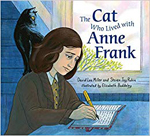 Mouschi, the cat of Peter, whose family hid with the Franks in the Secret Annex over a spice factory in Amsterdam during the Holocaust, tells how he too is in hiding because Jews are forbidden to own pets. Mouschi, along with the eight people living in the annex, must stay silent during the day to avoid detection. Unlike them, however, he is free to explore the streets crowded with “Black Spiders” (Nazi soldiers) and witnesses and reports on what is happening to “Yellow Stars” (Jewish people) in the city. Narration from the point of view of Mouschi and incorporation of hand-lettered excerpts from Anne Frank’s diary in expressive mixed-media illustrations make this picture book an accessible introduction to the Anne Frank story. Back matter includes biographical information about Anne Frank, a note on the characters and places in the story, and sources.
Mouschi, the cat of Peter, whose family hid with the Franks in the Secret Annex over a spice factory in Amsterdam during the Holocaust, tells how he too is in hiding because Jews are forbidden to own pets. Mouschi, along with the eight people living in the annex, must stay silent during the day to avoid detection. Unlike them, however, he is free to explore the streets crowded with “Black Spiders” (Nazi soldiers) and witnesses and reports on what is happening to “Yellow Stars” (Jewish people) in the city. Narration from the point of view of Mouschi and incorporation of hand-lettered excerpts from Anne Frank’s diary in expressive mixed-media illustrations make this picture book an accessible introduction to the Anne Frank story. Back matter includes biographical information about Anne Frank, a note on the characters and places in the story, and sources.
—CA
Girls with Guts!: The Road to Breaking Barriers and Bashing Records. Debbi Gonzales. Ill. Rebeca Gibbon. 2019. Charlesbridge.
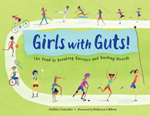 This engaging informational picture bookis a lively introduction to women athletes who “competed when others said they shouldn’t—or couldn’t” including Gertrude Ederle, who became the first woman to swim the English Channel in 1926; Althea Gibson, who became the first black athlete to win a Grand Slam tennis title in 1956; and Donna de Varona, who won medals as a member of the US Olympic swimming team in 1964. The book also traces the activities of Congresswoman Edith Green, Shirley Chisolm, Patsy Mink, and other activists who advocated for equal academic and athletic opportunities for girls. Their challenges to unfair federal funding eventually led to the passage in 1972 of Title IX, which mandated equal treatment for girls under any educational program or activity receiving Federal financial assistance. Backmatter includes an extensive time line (from 1880–1890 to 2017), author’s note, and a bibliography.
This engaging informational picture bookis a lively introduction to women athletes who “competed when others said they shouldn’t—or couldn’t” including Gertrude Ederle, who became the first woman to swim the English Channel in 1926; Althea Gibson, who became the first black athlete to win a Grand Slam tennis title in 1956; and Donna de Varona, who won medals as a member of the US Olympic swimming team in 1964. The book also traces the activities of Congresswoman Edith Green, Shirley Chisolm, Patsy Mink, and other activists who advocated for equal academic and athletic opportunities for girls. Their challenges to unfair federal funding eventually led to the passage in 1972 of Title IX, which mandated equal treatment for girls under any educational program or activity receiving Federal financial assistance. Backmatter includes an extensive time line (from 1880–1890 to 2017), author’s note, and a bibliography.
—CA
Stubby: A True Story of Friendship. Michael Foreman. 2019. Andersen Press USA.
 A soldier narrates this true story of a stray dog that entered an Army training camp in Connecticut, in 1917, looking for food, and was befriended by the soldiers, including the narrator who instead of leaving the dog behind, takes Stubby with him on the train and then the ship across the Atlantic. Stubby, who, with his keen hearing warns soldiers of approaching enemy and with his keen sense of smell warns them of gas attacks, becomes a war hero. Realistic illustrations in luminous watercolor and graphite show scenes of war in the trenches and the power of friendship. Back matter includes an archival photograph of Stubby with his medals and more information about Stubby, Corporal Robert Conroy, their experiences on the front lines, and Stubby’s valor and life after the war.
A soldier narrates this true story of a stray dog that entered an Army training camp in Connecticut, in 1917, looking for food, and was befriended by the soldiers, including the narrator who instead of leaving the dog behind, takes Stubby with him on the train and then the ship across the Atlantic. Stubby, who, with his keen hearing warns soldiers of approaching enemy and with his keen sense of smell warns them of gas attacks, becomes a war hero. Realistic illustrations in luminous watercolor and graphite show scenes of war in the trenches and the power of friendship. Back matter includes an archival photograph of Stubby with his medals and more information about Stubby, Corporal Robert Conroy, their experiences on the front lines, and Stubby’s valor and life after the war.
—SW
Ages 9–11
Last of the Name. Rosanne Parry. 2019. Carolrhoda/Lerner.
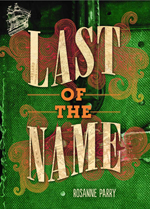 In early 1863, 12-year-old Daniel O’Carolan and his older sister Kathleen emigrate from Ireland with their grandmother, the last of their family, to New York City. After their grandmother dies at sea, the children arrive with a bundle she left them. Through the Catholic Church, Kathleen and Daniel, disguised as a girl named Mary, find rooms and domestic work in the house of a wealthy family. Daniel charms townspeople with his golden voice and haunting Irish songs but their lives become endangered during five days of draft riots in the summer of 1863 that include many Irish protestors. Kathleen and Daniel discover their family history revealed in their grandmother’s bundle. Front matter contains a map of Lower Manhattan with places, both fictional and real, featured in the book. The back matter includes an author’s note with more information on 19th-century immigration of Europeans to America and changes in the demographics of New York City, books for further reading, and questions for discussion.
In early 1863, 12-year-old Daniel O’Carolan and his older sister Kathleen emigrate from Ireland with their grandmother, the last of their family, to New York City. After their grandmother dies at sea, the children arrive with a bundle she left them. Through the Catholic Church, Kathleen and Daniel, disguised as a girl named Mary, find rooms and domestic work in the house of a wealthy family. Daniel charms townspeople with his golden voice and haunting Irish songs but their lives become endangered during five days of draft riots in the summer of 1863 that include many Irish protestors. Kathleen and Daniel discover their family history revealed in their grandmother’s bundle. Front matter contains a map of Lower Manhattan with places, both fictional and real, featured in the book. The back matter includes an author’s note with more information on 19th-century immigration of Europeans to America and changes in the demographics of New York City, books for further reading, and questions for discussion.
—SW
The Unsung Hero of Birdsong, USA. Brenda Woods. 2019. Nancy Paulsen/Penguin.
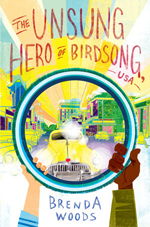 Excited about riding the Schwinn Deluxe he receives on his twelfth birthday, Gabriel Haberlin does not see Mrs. Babcock racing through town in her yellow Roadmaster. Meriwether Hunter, who served in the 761st Tank Battalion, nicknamed “the Black Panthers,” and resettled with his family in Birdsong, South Carolina, pulls Gabriel to safety and fixes his damaged bicycle. When Gabriel extols the town’s events to honor war heroes, Meriwether explains that colored men, who fought side by side with white soldiers, are not part of the parade and must keep their war stories secret because their physical safety, even their lives, are threatened when white people learn of their experiences. Gabriel learns lessons about friendship, racism, resourcefulness, and valor after he asks his father to give Meriwether a job as a mechanic in his auto garage and witnesses the prejudice of the other mechanic rumored to have Ku Klux Klan connections. Acknowledgments in the back detail contributions of men and women of color in the armed forces.
Excited about riding the Schwinn Deluxe he receives on his twelfth birthday, Gabriel Haberlin does not see Mrs. Babcock racing through town in her yellow Roadmaster. Meriwether Hunter, who served in the 761st Tank Battalion, nicknamed “the Black Panthers,” and resettled with his family in Birdsong, South Carolina, pulls Gabriel to safety and fixes his damaged bicycle. When Gabriel extols the town’s events to honor war heroes, Meriwether explains that colored men, who fought side by side with white soldiers, are not part of the parade and must keep their war stories secret because their physical safety, even their lives, are threatened when white people learn of their experiences. Gabriel learns lessons about friendship, racism, resourcefulness, and valor after he asks his father to give Meriwether a job as a mechanic in his auto garage and witnesses the prejudice of the other mechanic rumored to have Ku Klux Klan connections. Acknowledgments in the back detail contributions of men and women of color in the armed forces.
—SW
Ages 12–14
The Good Son: A Story from the First World War Told in Miniature. Pierre-Jacques Ober. Ill. Jules Ober & Felicity Coonan. 2019. Candlewick Studio/Candlewick.
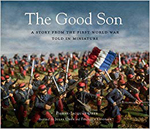 In 1914, during the war that was supposed to last only a few months, soldiers continue to march to battle—except for one. Pierre, a young French soldier, who had gone home for two days to spend Christmas with his widowed mother. Upon returning to his regiment, Pierre is imprisoned and sentenced to death for desertion. Told with a minimal text and intriguing photographs of tableaus created with toy soldiers, this thought-provoking story of a good son who wanted to be a good soldier ends with “About one hundred years ago, the whole world went to war. It was supposed to last months. It was supposed to be over by Christmas. It was fought by little soldiers like Pierre. It would be won by little soldiers like Pierre. But not by Christmas. And not by Pierre.” Back matter includes a note from the author or his connection to the story and notes and photographs of the process used in creating the book.
In 1914, during the war that was supposed to last only a few months, soldiers continue to march to battle—except for one. Pierre, a young French soldier, who had gone home for two days to spend Christmas with his widowed mother. Upon returning to his regiment, Pierre is imprisoned and sentenced to death for desertion. Told with a minimal text and intriguing photographs of tableaus created with toy soldiers, this thought-provoking story of a good son who wanted to be a good soldier ends with “About one hundred years ago, the whole world went to war. It was supposed to last months. It was supposed to be over by Christmas. It was fought by little soldiers like Pierre. It would be won by little soldiers like Pierre. But not by Christmas. And not by Pierre.” Back matter includes a note from the author or his connection to the story and notes and photographs of the process used in creating the book.
—CA
A Slip of a Girl. Patricia Reilly Giff. 2019. Holiday House.
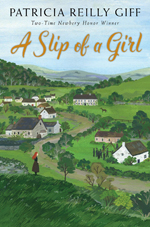 In this free-verse novel set during the time of the Irish Land Wars brought about by the rebellion of Irish tenants to eviction by English landlords for failing to pay unreasonable rents, Anna Mallon is determined to honor the promises she made to her dying mother: to keep her baby sister Nuala safe and protect the Mallon’s house and land. When Anna breaks the earl’s window after failing to meet with him about an extension on their rent payment, she and her father are jailed. She escapes and makes the long journey with Nuala to an elderly aunt’s home. They are safe, but with news of the growing unrest of tenant farmers, Anna knows she must go home. “I’ll be strong / to get back what belongs / to us, / what has always belonged: / our house, / our land.” Captioned archival photographs interspersed among the poems help set the scene. Back matter includes a glossary and an author’s note.
In this free-verse novel set during the time of the Irish Land Wars brought about by the rebellion of Irish tenants to eviction by English landlords for failing to pay unreasonable rents, Anna Mallon is determined to honor the promises she made to her dying mother: to keep her baby sister Nuala safe and protect the Mallon’s house and land. When Anna breaks the earl’s window after failing to meet with him about an extension on their rent payment, she and her father are jailed. She escapes and makes the long journey with Nuala to an elderly aunt’s home. They are safe, but with news of the growing unrest of tenant farmers, Anna knows she must go home. “I’ll be strong / to get back what belongs / to us, / what has always belonged: / our house, / our land.” Captioned archival photographs interspersed among the poems help set the scene. Back matter includes a glossary and an author’s note.
—CA
Ages 15+
Someday We Will Fly. Rachel DeWoskin. 2019. Viking/Penguin.
 Lillia narrates the story of the journey she takes with her circus performer father and younger sister when they flee 1940 Warsaw, Poland, leaving behind her mother who has disappeared. Escaping by car out of Warsaw, they take a train from Lithuania to Italy and sail to Shanghai, which is occupied by the Japanese Army but is one of few places in the world welcoming Jewish refugees. The family finds shelter in Hongkou, and her father searches for employment as they eke out survival. Always hungry but wanting to hold onto her old self as she discovers a new self, Lillia continues her dance and acrobat practice and attends the Kaadori School, where she befriends, Wei, a Chinese boy who acts as the school’s janitor but wants to be a student, and learns Chinese. As her new self, Lillia ventures into the International Settlement and becomes a dancer at a night club, a job she keeps secret from her family, but their lives change when Japan bombs Pearl Harbor in 1941. Back matter includes an author’s note detailing research in Shanghai and separating fact from fiction and sources consulted.
Lillia narrates the story of the journey she takes with her circus performer father and younger sister when they flee 1940 Warsaw, Poland, leaving behind her mother who has disappeared. Escaping by car out of Warsaw, they take a train from Lithuania to Italy and sail to Shanghai, which is occupied by the Japanese Army but is one of few places in the world welcoming Jewish refugees. The family finds shelter in Hongkou, and her father searches for employment as they eke out survival. Always hungry but wanting to hold onto her old self as she discovers a new self, Lillia continues her dance and acrobat practice and attends the Kaadori School, where she befriends, Wei, a Chinese boy who acts as the school’s janitor but wants to be a student, and learns Chinese. As her new self, Lillia ventures into the International Settlement and becomes a dancer at a night club, a job she keeps secret from her family, but their lives change when Japan bombs Pearl Harbor in 1941. Back matter includes an author’s note detailing research in Shanghai and separating fact from fiction and sources consulted.
—SW
Susan B. Anthony (The Making of America #4). Teri Kanefield. 2019. Abrams.
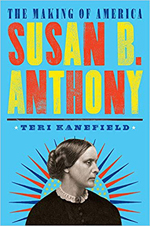 Born at a time when a woman had no rights to own property, to keep hard-earned income from her labors, or to have custody of her children if she divorced, Susan B. Anthony (1821–1905), known “as a woman ruled by logic, serenely self-assured, and dignified,” became an outspoken champion of women’s rights involving her in political action nationally, including extensive travel to western states that passed legislation for women’s suffrage. This biography, which includes archival images and photographs, shows Susan B. Anthony as a tireless and outspoken advocate for the rights and freedoms of women and African Americans in face of entrenched opposition, and describes her lifelong friendship and collaboration with Elizabeth Cady Stanton. The final chapter chronicles the changes in rights for women that followed Anthony’s death, including the passage of the 19th amendment to the Constitution of the United States in 1919. Back matter includes source notes; a timeline; excerpts from Anthony’s selected writings; a bibliography that includes primary sources, books, articles, and legal cases; acknowledgments; and an index.
Born at a time when a woman had no rights to own property, to keep hard-earned income from her labors, or to have custody of her children if she divorced, Susan B. Anthony (1821–1905), known “as a woman ruled by logic, serenely self-assured, and dignified,” became an outspoken champion of women’s rights involving her in political action nationally, including extensive travel to western states that passed legislation for women’s suffrage. This biography, which includes archival images and photographs, shows Susan B. Anthony as a tireless and outspoken advocate for the rights and freedoms of women and African Americans in face of entrenched opposition, and describes her lifelong friendship and collaboration with Elizabeth Cady Stanton. The final chapter chronicles the changes in rights for women that followed Anthony’s death, including the passage of the 19th amendment to the Constitution of the United States in 1919. Back matter includes source notes; a timeline; excerpts from Anthony’s selected writings; a bibliography that includes primary sources, books, articles, and legal cases; acknowledgments; and an index.
—SW
Sandip LeeAnne Wilson is a professor in the School of Education and the English Department of Husson University, Bangor, Maine, and is serving on the Children’s Literature and Reading SIG’s Notable Books for a Global Society Committee. Carolyn Angus is former director of the George G. Stone Center for Children's Books, Claremont Graduate University, in Claremont, California.